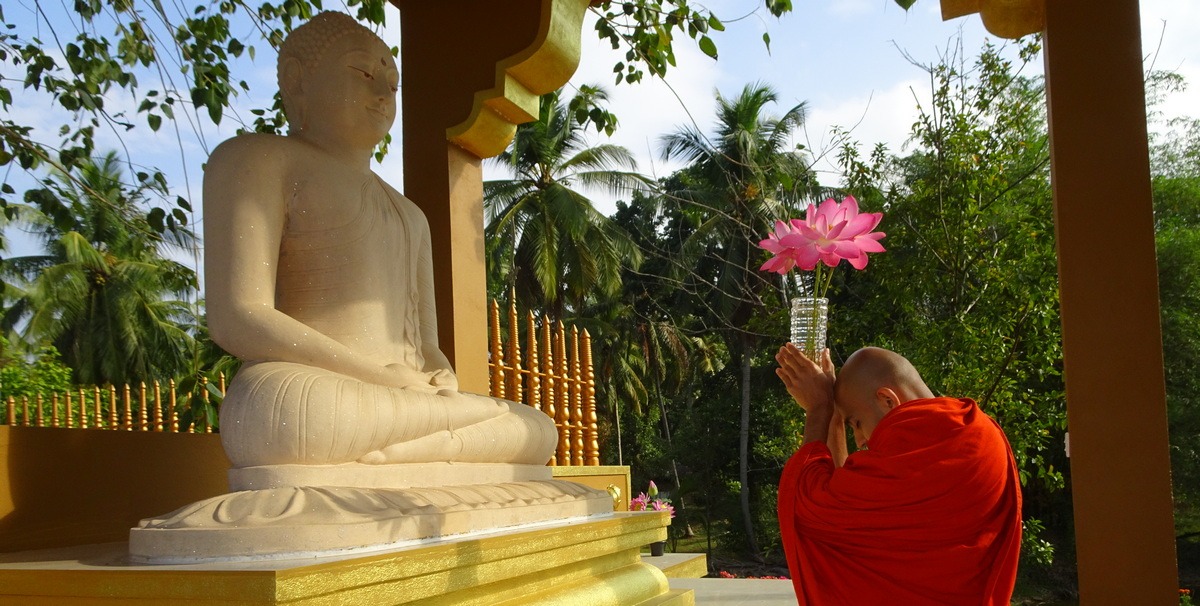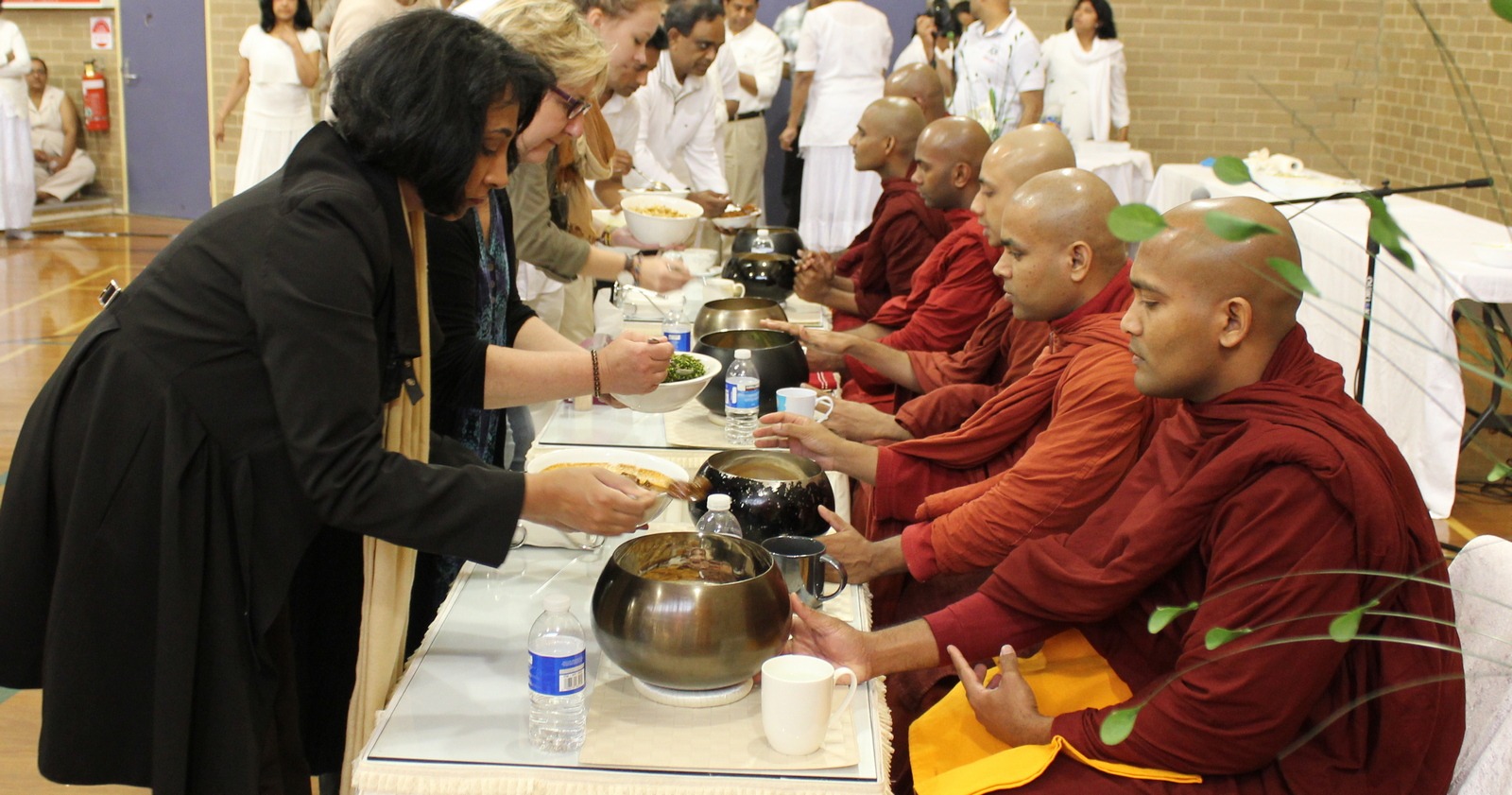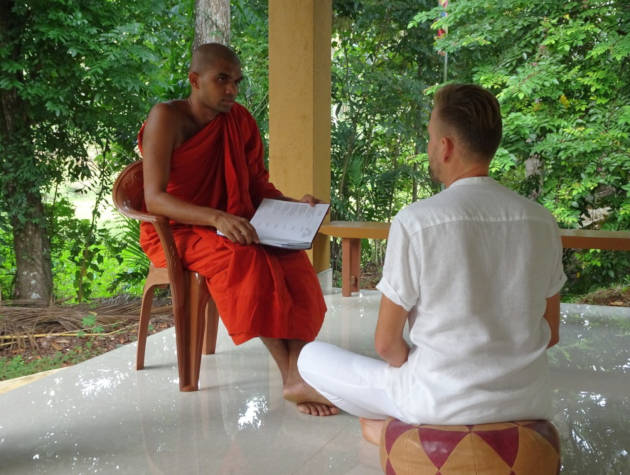
Every evening the monks get together, usually around 6 pm, to have a chanting service. Often local people will join in and you are welcome as well. This is a great way to get an experience of authentic Buddhist culture. It will usually begin by placing some items on the shrine. You may be invited to place some or just touch them as they are being carried.
There may be a chanting book in English for you to follow along with. You are also welcome to just listen. Below is a recording as well as the text of the first part of the service.
After the service, you are welcome to stay and speak with the monks.
Homage
Namo tassa bhagavato arahato sammā-sam-buddhassa
Namo tassa bhagavato arahato sammā-sam-buddhassa
Namo tassa bhagavato arahato sammā-sam-buddhassa
Homage to the Blessed One, the Worthy One, the supremely Enlightened One!
Homage to the Blessed One, the Worthy One, the supremely Enlightened One!
Homage to the Blessed One, the Worthy One, the supremely Enlightened One!
Going for Refuge
Buddhaṁ saranaṁ gacchāmi.
Dhammaṁ saranaṁ gacchāmi.
Saṅghaṁ saranaṁ gacchāmi.
Dutiyam’pi Buddhaṁ saranaṁ gacchāmi.
Dutiyam’pi Dhammaṁ saranaṁ gacchāmi.
Dutiyam’pi Saṅghaṁ saranaṁ gacchāmi.
Tatiyam’pi Buddhaṁ saranaṁ gacchāmi.
Tatiyam’pi Dhammaṁ saranaṁ gacchāmi.
Tatiyam’pi Saṅghaṁ saranaṁ gacchāmi.
I go for refuge to the supreme Buddha.
I go for refuge to the supreme Dhamma.
I go for refuge to the supreme Saṅgha.
For the second time I go for refuge to the supreme Buddha.
For the second time I go for refuge to the supreme Dhamma.
For the second time I go for refuge to the supreme Saṅgha.
For the third time I go for refuge to the supreme Buddha.
For the third time I go for refuge to the supreme Dhamma.
For the third time I go for refuge to the supreme Saṅgha.
Five Precepts
This section might be skipped depending on who is at the chanting service or it may be done call and response in Sinhala language.
1. I observe the precept of abstaining from killing beings.
2. I observe the precept of abstaining from stealing.
3. I observe the precept of abstaining from sexual misconduct.
4. I observe the precept of abstaining from telling lies.
5. I observe the precept of abstaining from taking intoxicating drinks and drugs.
I follow these precepts for happiness in this life for rebirth in heaven and to realize the Four Noble Truths in this Gautama Buddha’s Dispensation.
Buddhānussati: Contemplation on the Qualities of the Buddha
2. sammā-sam-buddho,
3. vijjā-carana-sampanno,
4. sugato, 5. lokavidū,
6. anuttaro purisa-damma-sārathi,
7. satthā deva-manussānam,
8. buddho, 9. bhagavā ti.
1. Such Indeed is the Blessed One, Arahant, worthy one,
2. supremely enlightened,
3. endowed with knowledge and virtue,
4. follower of the Noble Path,
5. knower of worlds,
6. the peerless trainer of persons,
7. teacher of gods and humans,
8. the Enlightened Teacher,
9. the Blessed One.
Dhammānussati: Contemplation on the Qualities of the Dhamma
2. sanditthiko, 3. akāliko,
4. ehipassiko, 5. opanayiko,
6. paccattam vedittabbo viññūhīti.
1. Well taught by the Blessed One is the Dhamma,
2. visible here and now,
3. timeless,
4. open to all,
5. learned and applied to oneself,
6. understood by the wise each for himself.
Sanghānussati: Contemplation on the Qualities of the Sangha
2. Uju-paṭipanno Bhagavato sāvaka-sangho.
3. Ñāya-paṭipanno Bhagavato sāvaka-sangho.
4. Sāmīci-paṭipanno Bhagavato sāvaka-sangho.
Yadidam cattāri purisa-yugāni aṭṭha purisa-puggalā esa Bhagavato
sāvaka-sangho:
5. āhu-neyyo 6. pāhu-neyyo
7. dakkhi-neyyo 8. anjali-karanīyo
9. anuttaram puññak-khettam lokassā ti.
1. Of pure conduct is the Order of Disciples of the Blessed One,
2. of upright conduct is the Order of Disciples of the Blessed One,
3. of wise conduct is the Order of Disciples of the Blessed One,
4. of generous conduct is the Order of Disciples of the Blessed One.
Those four pairs of persons the eight kinds of individuals:
that is the Order of Disciples of the Blessed One.
5. They are worthy of offerings,
6. they are worthy of hospitality,
7. they are worthy of gifts,
8. they are worthy of reverential salutations,
9. an incomparable field of merit for the world.
Satta Buddha Vandanā: Homage to the Seven Buddhas
Sikhissapi namatthu, sabba-bhū-tā-nukampino.
2. Vessabhussa namatthu, nahā-takassa tapassino.
Namatthu Kakusandhassa, Māra-senā-pamaddino.
3. Koṇāgamanassa namatthu, brāhmaṇassa vusīmato.
Kassapassa namatthu, vip-pamut-tassa sabbadhi.
4. Aṅgīrasassa namatthu, sakya-puttassa sirīmato.
Yo imaṁ dhamma-ṁadesesi, sabba-dukkhā-panūdanaṁ.
5. Ye cāpi nibbutā loke, yathā-bhūtaṁ vipassisuṁ.
Te janā apisuṇā, mahantā vītasāradā.
6. Hitaṁ deva-manussānaṁ, yaṁ namassanti Gotamaṁ
Vijjā-caraṇa-sampannaṁ, mahantaṁ vītasāradaṁ.
Vijjā-caraṇa-sampannaṁ, Buddhaṁ vandāma Gotamaṅ’ti.
1. Homage to Vipassi the Buddha possessed of the eye of wisdom and
splendor. Homage to Sikhi the Buddha compassionate towards all beings.
2. Homage to Vessabhu the Buddha free from all defilements
and possessed of great energy. Homage to Kakusanda the Buddha
the conqueror of the army of Māra.
3. Homage to Konagamana the Buddha who has shed all defilements
and has lived the holy life. Homage to Kassapa the Buddha who is fully freed from all defilements.
4. Homage to Aṅgirasa the Buddha Gotama son of the Sākyas
full of radiance who proclaimed the Dhamma that dispels all suffering.
5. Those in the world who have extinguished the flames of passion and have realized through insight things as they really are they never slander anyone they are mighty men who are free from fear.
6. Gotama the Buddha dear to gods and humans endowed with knowledge and virtue mighty and fearless we pay homage to our Great teacher Supreme Buddha.
After this the chanting will continue for about 30 minutes. Feel free to listen along silently if a chanting book is not provided.






Leave A Comment